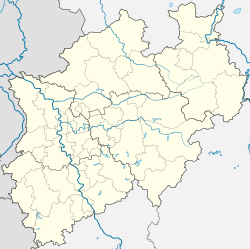Propsteikirche is the common name of a church in Dortmund, North Rhine-Westphalia, Germany, the only Catholic church in the city centre. The full name is Propsteikirche St. Johannes Baptist Dortmund. It was built from 1331 as the abbey church of a Dominican monastery. Consecrated in 1458, it features a late-Gothic high altar by Derick Baegert which shows the oldest depiction of Dortmund.
| Propsteikirche | |
|---|---|
| Propsteikirche St. Johannes Baptist | |
 | |
| 51°30′49″N 07°27′46″E / 51.51361°N 7.46278°E | |
| Location | Dortmund, North Rhine-Westphalia |
| Country | Germany |
| Denomination | Catholic |
| Website | www |
| History | |
| Status | church |
| Dedication | John the Baptist |
| Consecrated | 1450 |
| Architecture | |
| Functional status | active |
| Heritage designation | listed |
| Architectural type | hall church |
| Style | Gothic |
| Groundbreaking | 1331 |
| Demolished | 1943, rebuilt 1947–66 |
| Administration | |
| Diocese | Diocese of Paderborn |
The church became the first Catholic church in Dortmund after the Reformation, a Propsteikirche from 1859. Destroyed in World War II, it was rebuilt until 1966. Its organ, built in 1988, makes it a concert venue.
History
editA Dominican abbey was founded in Dortmund in 1330, and a first abbey church was built from 1331 to 1353, consecrated in 1354, dedicated to John the Baptist. It was soon expanded to a Gothic hall church, begun in 1404 and consecrated in 1458.[1][2] The church of a mendicant order, it was mainly a place for prayer and built simple and without a steeple.[3] The abbey was dissolved during the secularization in 1816. The church became the first Catholic parish church in Dortmund after the Reformation in 1819. It was promoted to a Provost church in 1859. The former abbey buildings were used to house the priest and as school buildings.[2]
The church was destroyed in World War II in 1943. Its most important art treasures had been removed, surviving the war. The church was rebuilt from 1947 to 1967.[1] It is a listed monument.[2]
Altar
editThe church features a late-Gothic high altar by Derick Baegert, focused on the themes of the Passion and Crucifixion. It shows in the background of the left panel the oldest depiction of Dortmund.[1]
Organ
editThe present organ was built in 1988 by Siegfried Sauer. It is often used for concerts and recordings. It is a universal organ with 52 stops on three manuals and pedal.[4]
Literature
edit- Elisabeth Baxhenrich-Hartmann, Der Hochaltar des Derick Baegert in der Propsteikirche zu Dortmund, Studien zur Kunst- und Dominikanergeschichte Dortmunds in der 2. Hälfte des 15. Jahrhunderts, Dortmund 1984
- Rolf Fritz, Museum für Kunst und Kulturgeschichte, Derick Baegert, Hochaltar der Propsteikirche Dortmund, Dortmund 1963
- Theodor Rensing, Das Dortmunder Dominikanerkloster (1309–1816), Münster 1936
- Norbert Reimann, Dortmund-Dominikaner, in: Westfälisches Urkundenbuch, Bd. 1, Münster 1992, S. 261–268.
- Wolfgang Rinke: Dortmunder Kirchen des Mittelalters. Dortmund 1991, ISBN 3-7932-5032-6
- Wolfgang Rinke: Der Altar in der Propsteikirche zu Dortmund – Geschichte, Kunstgeschichte, Bildbeschreibung. Cramers Kunstanstalt, Dortmund 1992. ISBN 3-924302-53-7
- Thomas Schilp, Barbara Welzel: Die Dortmunder Dominikaner im späten Mittelalter und die Propsteikirche als Erinnerungsort. Verlag für Regionalgeschichte. Bielefeld 2006. ISBN 3-89534-628-4
References
edit- ^ a b c Glas, Rüdiger. "Propsteikirche St. Johannes d. T. Dortmund". baukunst-nrw (in German). Retrieved 22 December 2014.
- ^ a b c "Nr. 0375" (PDF). Denkmalliste der Stadt Dortmund (in German). 14 April 2014. Archived from the original (PDF) on 15 September 2014. Retrieved 12 June 2014.
- ^ "Dominikaner kommen nach Dortmund". Baudenkmale im Ruhrgebiet (in German). Retrieved 22 December 2014.
- ^ Orgel Propsteikirche
External links
edit- Official website
- Dortmund, Dominikanerkloster Digitale Westfälische Urkunden-Datenbank (DWUD)
- Dortmund (D) - Propsteikirche St. Johannes Baptist - Vollgeläute (Turmaufnahme) on YouTube

